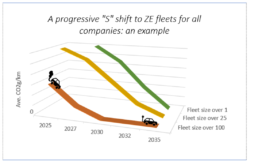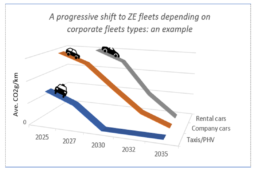Our answer to the Revision of the Combined Transport Directive – Inception Impact Assessment
16th September 2021PublicationsLogistic
Combined Transport Directive
Our answer to the consultation
Directive 92/106/EEC is the only EU legal instrument directly targeting combined transport (CT), incentivising a more sustainable operational model for freight transport. Nearly thirty years later, the effectiveness of the Directive needs to be improved as the freight market and transport have gone through considerable changes. Furthermore, the political context has shifted as well, with an increased ambition on emissions-reduction objectives deriving from the European Green Deal and the Sustainable and Smart Mobility Strategy.
The Platform for Electromobility agrees with the European Commission that, without an intervention to promote the use of multimodal transport, the uptake of more sustainable transport options will not take place to the desired degree and in the desired time-frame to reach 2030 and 2050 EU objectives.
Strengthening combined transport fits perfectly into the vision of an integrated and sustainable comprehensive mobility system. The role of intermodal terminals, in this context, stands out through the optimisation of the connectivity of the different modes, and incorporating rail, roads and waterway systems into the freight logistics chain.

Among the options envisaged by the Inception Impact Assessment, Option 3 appears as setting the most effective way to crucially improve the framework for combined transport in Europe. The extension of the support from today’s narrowly defined combined transport operations to all intermodal or multimodal operations, and the categorisation of terminals based on infrastructure and operational efficiency – both proposed also under Option 2 – would broaden the Directive’s scope and streamline investments for combined transport’s infrastructures.
Moreover, Option 3 foresees an assessment of the efficiency of the measures to support the attainment of the objectives of the revised Combined Transport Directive. This measure would improve the reporting and monitoring conditions of the Directive.
Following this further, the Platform remains cautious about the viability of Option 4, which envisages mandatory harmonised support measures – such as a support to transhipment costs. Such proposal may open the door to state aid-related questions and be challenged across Member States.
The Platform for Electromobility looks forward to work with the European Commission to ensure that freight transport do not miss the decarbonization revolution and contributes efficiently to a sustainable, integrated and multimodal mobility system for Europe and set best practices for the world.
Mandating zero-emission vehicles in corporate and urban fleets: guidelines for reflection for policy makers
10th September 2021PublicationsFleet
In a previous communication,
the Platform for electromobility,
an alliance of 45 industries, NGOs and associations covering the whole value chain and promoting the acceleration of the shift to electric mobility, called for a new single regulation dedicated to the complete decarbonisation of corporate fleets. Such fleets represent 63% of new registrations and, on average, drive more than double the number of kilometres of private cars. The largest leverage for CO2 reduction with reduced political risks. The Platform recommended adopting a gradual approach to eventually reaching the objective of 100% of new vehicle purchase in corporate fleets being fully electrified by 2030.
This paper follows up on the previous communication paper with the aim of providing policy makers with the information and figures to support the drafting of such new legislation. The elements presented below are intended to aid reflection on enshrining in law and implementing the EU Smart and Sustainable Mobility Strategy’s “actions to boost the uptake of zero-emission vehicles in corporate and urban fleets”. This commitment can be made concrete through a new EU legislative framework that mandates the transition to ZEVs (Zero Emission Vehicles) for company cars.[1]
A consensus on a regulation
Although the variables of such new legislation are being debated within industries and sectors, it is certain that a Regulation, rather than a Directive, is essential for a range of reasons. A Regulation will:
- Stimulate deployment of electric mobility in those countries where uptake is currently slowest. The logic for better-harmonised measures at the EU level arises from the need for the same level of effort against climate change within all Member States.
- Avoid the delays in implementation that a Directive might entail – such as can currently be seen with the Clean Vehicle Directive. With the climate change clock continuing to tick, the time needed to conclude negotiations on a Regulation would be compensated for by the inevitability of its direct implementation. A Regulation will reduce the transition time to electric mobility between those Member States that have already announced the phase-out of ICEs by 2030 (such as Sweden, Denmark, Netherlands, and Ireland) and others.
- Bring certainty to both EV manufacturers and those companies purchasing targeted fleets. Such certainty for manufacturers, along with ambitious CO2 emission performance standards for new cars and vans, will ensure that the supply of EVs meets the EU climate ambitions and avoid companies competing for a limited supply of ZEVs.
- Introduce stronger safeguards than a Directive against potential Member State market distortions, notably in the form of unfair price increases for the private fleet owners.
Variables to consider within the Regulation and potential options
That said, a range of options for the Regulation mandating ZEVs for company cars can be considered. These include regulation application threshold, timeline, average fleet consumption or a mandate on new purchases, etc. Below, the Platform provides examples from the debate within certain Member States.
Application threshold:
There must be a balance struck between covering a large proportion of company cars in Europe while not overly impacting smaller companies, where such a mandate could become an excessive financial and administrative burden.
The Platform proposes to target the largest companies first, as it is possible to mandate the electrification of most company cars. Table 1 shows the share of company cars in Spain managed by companies, according to the size of their fleet. For example, by mandating companies managing 20+ vehicles (i.e. medium and large companies, representing only 6.8% of the total), it would be possible to electrify 55.2% of all company cars. France has already chosen such an approach (this example is detailed in Annex I of this paper).

As well as making the greatest impact with the lowest burden on the economy overall, targeting the largest fleets first would also make the implementation and enforcement of the legislation more efficient. It is easier to control and scrutinise large entities with dedicated fleet management services than it is for microenterprises. Establishing a distinction between private and business use of corporate vehicles for these smaller companies would entail onerous and disproportionate costs and an excessive administrative burden in keeping appropriate records.
Application timeline:
This approach would allow the adoption rate to follow an ‘S-shape’ curve, with a slow increase to 2025 due to difference in the cost acquisition of ZEVs. After 2025, and with price parity between ICE vehicles and ZEVs, the adoption rate will begin to accelerate. An EU target will provide a clear threshold for companies, while leaving flexibility for those Member States that seek to move faster towards their goal. Ideally, the mandate would apply to the fleets of the largest companies before applying to smaller fleets, given that – as time goes on – the acquisition cost of EVs will diminish and more charging infrastructure will become available.

In order to avoid social backlash, the objectives of emission reduction for 2030 were set at a moderate level. Acting more rapidly on company cars during the period 2025-30 with more ambitious levels would allow a significant impact on decarbonisation while avoid impacting those with the lowest incomes. Small- and medium-sized enterprises should be supported during the transition, as they lack the analytics and training resources of bigger companies.
Transition pace:
The steepness of the transition curve is also an element that needs to be considered. To make all newly procured corporate vehicles zero-emission by 2030 will require rapid uptake. To achieve this, there are different potential pathways (linear growth, exponential growth, ‘S-shaped’ curve, etc.), for which the efficiency, fairness and preparedness should be assessed in the impact assessment.

Enforcement, incentives and penalties:
In order to enforce the legislation, a first step would be to establish a clear reporting system to keep track of new procurement. As a next step, some type of incentive and/or penalties framework should be created. Belgium is an example of an early adopter of such fiscal incentives. The fiscal benefits for ICE company cars will progressively decrease in the country, ultimately disappearing by 2026. Meanwhile, the fiscal benefits for EVs will be maintained. In France, there is a bonus and a premium for conversion that will apply from 2022 with potential renewal.
The levels set for such variables should be discussed with industry and stakeholders throughout the legislative process and consultation phases. This political objective will be translated with specific measures in each Member State. A recent study by T&E has shown how a wide range of measures, mostly fiscal, can be activated at national level. The study showed that, once applied, such measures are effective. If Member States decide not to enforce incentivising measures for companies, then penalties may fall on those companies that fail to comply.
[1] In the document, “company cars” are defined as any passenger cars that are part of a larger fleet within the commercial market channel. There are three common categories; i) short-term rental / rent-a-car; all registrations made by rental car companies; ii) OEMs / dealers / manufacturers – demonstrators, loan cars, one-day registration, 0km, registrations made by manufacturers against themselves; iii) true fleets – all except the above categories.
Corporate cars: the n°1 leverage to boost EV uptake
The Platform recommended setting a gradual approach to progressively but eventually reach the objective of 100% of new vehicle purchase in corporate fleets to be fully electrified by 2030. Discover why here.
Discover information and figures supporting the drafting of a mandate on corporate cars electrification.
Agenda and Speakers
| Welcome address | Cedric Thoma, WG Chair, Tesla | |
| Setting the scene | Michelangelo Aveta, Eurelectric | |
| Presentation of the recommendations form the Platform | Saul Lopez, T&E | |
|
|
Reaction from European institution
Reaction from stakholders |
Dario Dubolino, DG MOVE
Richard Knubben, Leaseurope |
| Q&A from attendees | Cedric Thoma, WG Chair, Tesla |
Know more about corporate fleets
Company cars[1] are the elephant in the room that leads Europe to reach its new −100% target in 2035. Corporate fleets represent an estimated 63%[2] of new registrations in 2021 and drive on average 2.25 times more kilometres than private cars. The decarbonisation of company cars is a key leverage to reach climate target with reduced political risks. While immediate results are clear for the planet, there are also strong second-hand impacts on democratisation and affordability of EVs for everyone, without making the low-income classes bear the cost of the transition.
The Platform for electromobility organises an event to raise awareness among stakeholders and policy makers on the obvious, but nonetheless overlooked, benefit the electrification of company cars can trigger. To make this necessary step forward and grab this low-hanging fruit, the Platform recommends setting a gradual approach to progressively but eventually reach the objective of 100% of new vehicle purchase in corporate fleets to be fully electrified by 2030. The Platform outlined in recent publication why and how to create this mandate.
The event will showcase best practices from major fleet owners and companies that have committed to electrify their fleets. It will also be the opportunity to hear reactions from institutional stakeholders and on they actually intent to enshrine in law and implement the EU Smart and Sustainable Mobility Strategy’s announced “actions to boost the uptake of zero-emission vehicles in corporate and urban fleets”.
[1] Any passenger car that is part of a larger fleet within the commercial market channel. Three categories are commonly taken into account : -Short-term rental / Rent-a-car : all registrations made by rental car companies ; -OEMs / dealers / manufacturers : Demo’s, loan cars, one day registration, 0km, registrations made by manufacturers against themselves ; -True fleets : All except the above categories.
[2] https://www2.deloitte.com/content/dam/Deloitte/cz/Documents/consumer-and-industrial/cz-fleet-management-in-europe.pdf
Position paper on CO2 standards for cars and vans
15th June 2021PublicationsEU Industrial Strategy
Position paper on CO2
Standards for cars and vans
The Platform for Electromobility supports the overall greenhouse gas emissions reduction target of 55% by 2030 and the climate neutrality objective by 2050. Reducing – and ultimately eliminating – emissions from cars, vans and trucks will be key to achieving these objectives.
The Platform for Electromobility would like to emphasise that the EU CO2 standards regulation delivers genuine benefits for transport, setting clear signals to both car makers and consumers on the required pace for the transition to zero-emission mobility. This regulation is the most effective way to do so, when compared to the extension of the ETS system to road transport.
The future cars and vans CO2 legislation will increase the offer and promote the market uptake of zero-emission vehicles. With an increased market, zero-emissions vehicles will also become more affordable with a continuously reduced total cost of ownership and more choice for consumers and will also help tackle air quality and noise issues, bringing an overall benefit to society.

For Europe to become carbon neutral by 2050, road transport needs to be entirely decarbonised by this date. Considering the average retirement age of petrol and diesel vehicles in Europe (around 15 years), the Platform for Electromobility believes that an EU-wide phase-out date for sales of new pure internal combustion engine passenger cars and vans no later than 2035 is necessary to achieve this objective with a clear emissions reductions trajectory. After 2035 looking at the overall life cycle carbon footprint of vehicles could be a relevant factor to consider.
Setting binding annual CO2 targets would be optimal from a climate perspective and would ensure a continuous CO2 emissions reduction trajectory. Such targets should follow a long-term emission reduction trajectory to ensure sufficient visibility for industry (ensuring annual targets are set sufficiently in advance, and minimum of 5 years). The current design of the car and vans CO2 regulation targets – whereby targets kick-in in five years intervals with no emission reductions required in between – is suboptimal from a climate perspective and means CO2 emissions actually increase in between, as was seen between 2016 and 2019 from new car sales.
The revised regulation should set significantly higher targets for CO2 emissions from 2030 and adding a binding interim target in 2027 of at least 37,5% CO2 emissions reduction (a date consistent with the technology reset required by the Euro 7 emission standard) to secure a more linear CO2 emission target trajectory and ensure new vehicles can fairly contribute to the higher overall GHG reduction target for 2030.
In addition to the CO2 targets, a mechanism incentivising zero-and low-emissions vehicles (ZLEV) should be maintained in the period up to 2030. Only zero-emissions vehicles should be eligible for the incentive system, as well as vehicles with emissions below a threshold lower than 40 g CO2/km. Ultimately, the ZLEV benchmark/mandate level should be adapted from 2030 onwards, and only zero-emission vehicles should be eligible for any incentive system. The Platform for Electromobility considers that another incentive type could be envisaged – based on an accurate impact assessment and analysis – in the form of a bonus-malus for the period up to 2030 with a realistic threshold. After 2030, the bonus would be removed to be replaced by a unique malus.

In addition, regarding specificities of vans (professional purposes, goods & persons transport) it should be considered to differentiate between the target levels for cars and vans until 2035.
The Platform is opposed to any mechanism that would consider the contribution of renewable and low carbon fuels in the compliance assessment for each manufacturer. Policies focused on decarbonising fuels and those focused on reducing emissions from cars and vans must remain in separate legal instruments.
We would like to underline that new skills and qualifications for workers in the automotive value chain will be needed. Excess emission premiums, which are paid by OEMs whose average specific emissions of CO2 exceeded their specific targets and whose amounts are considered as a revenue for the general budget of the EU, should be allocated to a new or existing fund or relevant programme with the objective of ensuring a just transition towards a climate-neutral economy, in particular to support re-skilling, up-skilling and other skills training and reallocation of workers in the automotive sector and ecosystem.
Data collected from fuel consumption meters (FCMs) – fitted as standard on all new cars from 2021 onwards – should be used for consumer information and vehicle labelling purposes, either via a review of the car labelling directive, or via direct amendments to the cars CO2 regulation, and from 2025 onwards be used for compliance with CO2 targets.
The Platform supports removing the target mass adjustment mechanism. Removing the target mass-adjustment mechanism has many benefits: it removes a structural weakening of the regulation; ensures that all carmakers have the same target therefore pushing the larger and more polluting segments to electrify more rapidly, in line with their heavier climate impact; and it simplifies the regulation.

The decarbonisation of the transport sector needs a holistic approach. The planned revision of the Alternative Fuels Infrastructure Directive (AFID) needs to support the harmonised roll-out of a high-quality charging infrastructure for BEVs. It should be turned into a regulation for road transport infrastructure and set minimum mandatory targets per Member States for the deployment of publicly accessible charging points with a minimum quality service requirement that are accessible for every consumer.
The Platform for Electromobility urges the Commission to seize the unique opportunity of the Fit for 55 package and of the Green Recovery Fund to achieve the EU Green Deal’s goal to fully decarbonise road transport by 2050 and make electromobility a lifelong reality.


